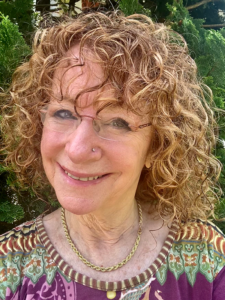Home > Listen to the Sounds of Silence: Building Our Capacity for Presence
Listen to the Sounds of Silence: Building Our Capacity for Presence
by Michele Bograd
Every end-of-life doula is taught that being able to hold silence is a crucial element of cultivating presence and nurturing relationships. Like a billboard, the acronym WAIT (Why Am I Talking) reminds us to slow down to listen, to wait, to allow. But the capacity to be silent is more than just not talking. It is a muscle, a skill that needs to be nourished, practiced, and understood. What is silence, really? Does silence come easily to you, or is it an uncomfortable experience? How has your history shaped your capacity for silence? Are we curious about the impact of silence on the people we serve? How would our EOLD practices change if silence were as much of our foundation as are words?

Silence as Communication
In Western culture, sounds bombard us: in restaurants, in elevators, at malls, in our ever-present earbuds. In contrast, silence implies negative space: the absence of sound or noise, the omission of something meaningful, simply a pause. To nurture, value, and become comfortable with silence, EOLDs need to change our understanding of silence from the lack of communication or connection to the recognition that silence is communication (Kaye et al, 2022; López Gutiérrez & Arroyo Paniagua, 2024). Researchers on silence demonstrate that people perceive silences much as we hear sounds—as an interpersonal event imbued with meaning and relationship. Silence is not simple but contextual and multifaceted. Like any element of communication, it can have a positive, neutral, or negative impact. We have all experienced the awkward silence of not knowing what to say, the companionable silence with a dear friend, the silence that is expecting an answer, and the silence that is punishing or disapproving. Not all silences are equal.
Is Silence Comforting, Neutral, or Intolerable?
Silence is not useful in and of itself. It can be positive and healing, or negative and disruptive. To impact interpersonal processes, an EOLD can thoughtfully use silence to intensify, to pause, to de-escalate, to comfort. We alter our pace, the noise of our speaking and guiding, to give people time to concentrate, to find their words, to just be with what is. Silence benefits the EOLD in equal measure. When we are quiet, we can witness but not act on our impulses to reassure, to comfort, to fix, to educate. We also learn about ourselves: Am I afraid, not feeling useful, wanting my client to do something or to be someone different? Silence also helps us self-regulate in a context that is often fast-changing and intense, giving ourselves time to metabolize what we are feeling at a given moment to make more considered or wiser choices. Lastly, silence helps create a sacred container, allowing us to understand more about spirit (however you define it) and death itself. “Within each of us is inner space of sacred emptiness which holds qualities of love and compassion, mercy and gratitude, forgiveness and wisdom… Characteristic of that sacred emptiness…as well as the key to it, is silence” (Singh, 1998). This is silence at its best.
On the other hand, EOLDs can use silence in unproductive ways, especially when we just stop talking because we believe we are “supposed” to be quiet. “[T]his ‘just do it,’ behavior-focused ‘use’ of silence creates a new, different problem: the clinician looks uncomfortable using silence, and worse, generates a palpable atmosphere of unease that feels burdensome to both the patient and clinician. We think that clinicians are largely responsible for the effect of silence” (Back, Bauer-Wu, Rushton & Halifax, 2009). Think about whether your silence may have an unintended negative impact on your client who may read it as signaling disengagement or boredom. Rather than nurturing open, present receptivity, your silence may result from feeling overwhelmed, helpless, or frozen. Those states, and the presence of silence or “empty” space, may catalyze the EOLD’s “frantic movement forward filling every painful moment with words” (Wolfelt, 2012). We interfere with the silence that may provide the greatest comfort to our clients. What are examples of this?
- An EOLD falls silent. The person they are supporting begins to weep. The EOLD breaks the silence “to help him be in a better mood.”
- A woman in home hospice is chatting and stops talking. The EOLD sits companionably with her. The hospice patient announces, “It feels like no one wants to talk to me anymore, including you.”
- A dying person and an EOLD are sitting quietly. The EOLD appears restless, looking out the window. The dying person starts to chat about the autumn leaves. Is that for their own sake or for the EOLD?
- A doula is heartbroken about the rapid decline of the person they are supporting with ALS who employs a keyboard to communicate. It is slow and laborious. Rather than wait, the doula interrupts and guesses what the person is in the middle of typing. “Please don’t,” says the person. When the doula is still, they feel close to tears.
- An EOLD is quiet after a person with stage 4 pancreatic cancer shares they are stopping treatment. After a moment, the person with cancer asks, “Are you not saying anything because you’re mad at me?”
- A doula is keeping vigil at the bedside of someone they don’t know. The doula is silent but underneath it, they are anxious, bored, and fidgety—fighting the temptation to pull out their cell phone.
These examples demonstrate the nuance and complexity of silence. Doulas can fall silent out of anger, disinterest, boredom, disapproval, or overwhelm—and that may be sensed by the client. Even if we think our silence is “holding space,” a client can feel disengaged or abandoned. Clients can also read into our silence—not always accurately—but many will not comment upon it. They may sense your discomfort with silence and so talk to take care of you, moving away from what they may be needing. Most importantly, if the EOLD cannot tolerate silence—filling it with questions, projects, chatter, or music—opportunities for connection and intimacy are lost.
Personal History and Our Capacity to Be Silent
Our individual capacity to be silent has many sources. One is cultural. Think of a loud, boisterous family where interrupting one another is a form of love, in contrast to a family whose cultural norms mute emotion and read silence as a form of respect. Gender may also play a role, as does social location. I have found that a potent predictor of a doula’s comfort with silence is one’s family of origin.
There are several entry points to the exploration of personal history and silence. Consider the role you typically take in a new group. Are you the one to speak first, or last? Do you hold back or reveal? Do you watch and wait, observing patterns and then commenting upon them? If there are awkward pauses in groups, as there often are, do you rush to fill them? Does watching family members struggle to find a focus evoke your urgent need to make connections, to break the tension with humor, to check in with someone who appears disengaged? What would it mean to you to say nothing, to do nothing—recognizing in fact that silence is actually doing something? What do you notice inside when you hold back from words or actions, yet remain open and curious?
Our ability to trust and nurture silence usually has deep roots in our families of origin. Take a moment and settle yourself. Float yourself back in time. Ask the questions: What did I learn about silence growing up? Was there silence in my family? Was it comfortable? Was I allowed to be silent? How did family members respond to silence? What did silence mean?
I’ve led this exercise with many groups of EOLDs. Frequently, the first response is that silence signaled danger. “In my family, silence meant my father was angry. Just remembering it now, I feel kind of panicky. It meant an explosion was on the way.” Silence can also signal disconnection: “There wasn’t yelling in our household. But if Mom was mad at me, she went cold and quiet, and it could last for hours and even days.” Families can also view silence as worrisome or negative: “If I was quiet, my sister would immediately say to me, ‘Are you OK? Is something wrong?’ I never learned to just be with myself.”
In contrast, other EOLDs report they learned silence can be companionable. “I remember my grandmother and I would just sit together and I’d draw. I felt so loved by her.” Other doulas shared that they were rewarded for being quiet: “My sister had a big personality and fought with my parents endlessly. I learned to be the good, quiet, compliant child. It’s hard for me to speak up, actually.” Others describe a resistance to their family culture: “My family never talked about anything. Ignoring, saying nothing, was the norm. I’m impatient when people are quiet. I don’t like silence and I try to figure out what’s really going on.” Lastly, some doulas spoke about the relationship of silence and social power: “My parents were immigrants and were often quiet because of language differences. They had no voice. I was the translator and I worked hard to include them. I realize, as a doula, I’m always ‘hosting’ and making sure everyone is OK. I just can’t sit still and be silent.”
Our family-of-origin templates are neither good nor bad. In fact, these templates are often the foundations of our individual doula skills. The dilemma occurs when we are unaware of our templates. Then we operate automatically, with blind spots. In contrast, if I know as a doula that silence evokes fear or vigilance for me, I can expand the meanings of silence for myself as I work to keep my body calm. If I know that my operating system includes becoming a caretaker when people in my family are quiet, I can practice being less active, less wordy. The exploration of silence, past and present, teaches us where we need to grow as doulas.
Evolving Interactions of Silence
As we explore our personal patterns around silence, they evolve. Ideally, as EOLDs, our ability to be silent, receptive, and engaged expands. But our personal capacity to be silent is not sufficient. We are interacting with individuals with life-limiting illness and their caregiving systems. Those people have their own tolerances for or reactions to silence. Silence is also shaped by the development of trust and the trajectory of illness. Some clients are quiet and private and become more open and talkative as the relationship deepens. Others are chatty at first, but desire more silence as trust is built. For many, the capacity of the EOLD to hold silence as their disease progresses is essential. Silence creates a space for an overwhelmed person to find words for their feelings. A person whose concentration is compromised by fatigue or disease can gather their thoughts in their own time. In silence, the person who is no longer lucid or conscious can be accompanied and served without language. Silence allows us to closely be within “slow time.” As the poet Mary Oliver (2006) writes, “…put/a few words together and don’t try/to make them elaborate, this isn’t/a contest but a doorway/into thanks, and a silence in which/another voice may speak.”Growing Our Capacity for Silence
The best strategies for developing one’s capacity for silence are intention, inner exploration, and active noticing. In the intense mix of figuring out what to do or to provide to the dying and their caregivers, EOLDs often forget to be silent. To develop this capacity, mindfully experiment with being silent. By mindful, I mean more than simply stopping talking but turning to silence as an essential element of relationships. Kaye et al (2022) suggest: “[D]eliberately create a wordless space that is saturated with active presence, bridged by connectional body language, and anchored in an intention to bear witness… [C]onsciously allow the patient and family to lead us out of the silence… [B]e deliberate about introducing a series of quiet spaces across the conversation.”

Inner exploration follows:
Is my silence shutting me down or opening me up?
What am I feeling emotionally?
What am I sensing in my body?
Why am I feeling it?
How do I bring myself to this present moment?
How do I still my thoughts and plans?
Focus on breath and grounding. The goal is to become receptive, not simply wordless. To do this, one must actively notice both inside and out.
Active noticing reminds us to be witnessing ourselves and others. What nonverbal cues am I seeing in my client or their loved ones? What is the energy between us? What is the silence communicating? Notice when you are chatting to avoid silence. Notice when you break silence out of discomfort. Listen to the silence. Remember the sounds of silence: Silence is filled with meaning. Learn to trust it.
Breaking the Silence to Reflect With Others
Because silence is inherently relational, we do not need to figure out its impact and meaning by ourselves. Paradoxically, essential to building the skill of holding silence is learning to talk about it with those we serve. If the client is silent, ask them what their silence means. Are they comfortable with the silence? Do they enjoy it? Ask them about their preference in that moment: shared quiet or conversation? Help them understand your own silence. For example, share that you are gathering your thoughts, or that you’re feeling connected even as you say little. Since the meaning of silence is different across people, and different for the same person at any given moment, create an agreement. You will check in with them when they are quiet but only to see if they want the silence to remain or not. Ask them also to interrupt your silence—to ask questions, to let you know if it’s uncomfortable for them. Let them know they can break the silence or ask you to be quiet. This process is a quick check-in to make sure you as an EOLD are attuned and responsive to the client.
Silence Not as Absence but as Foundation
Silence is not simply another skill in our EOLD tool bag. It is an active process. It is a quality of mind and spirit and relationship. It is a way of knowing, of bearing witness, of listening with your heart. What do we discover if we take silence—not as an exception or “break” from speaking—but as foundational? When we do this, the gestalt shifts. The basis of presence becomes receptive silence rather than language. We don’t stop speaking to be silent, but we break silence to speak. The skill of holding silence goes hand-in-hand with speaking wisely. “One should only speak when what we have to say is more precious than silence” (Arab proverb). From this perspective, we are not reminding ourselves to be silent but asking: What do I most hope my words accomplish?
There is a synergy between speaking and silence. Speaking wisely and with care fosters silence. Silence is often the ground for wise and caring words. As EOLDs, growing the capacity to foster and be with silence invites us to be courageous as we break our reliance on words and sounds. There is much to discover in silence. “There is nothing as silent as the room in which the newly dead lie. We hear both the absence of sound—gone the labored breathing and congestion, the intermittent breaths—as well as the presence of silence. The absence of sound is what is taken away; the presence of silence is what replaces it. In this silence, we listen with a kind of wonder.” (Joseph, 2023).
Back, A., Bauer-Wu, S., Rushton, C. & Halifax, J. (2009). Compassionate silence in the patient-clinician encounter: A contemplative approach. Journal of Palliative Medicine, 12 (12), 1113-1117. doi: 10.1089/jpm.2009.0175
Joseph, E. (2023). In the slender margin: The intimate strangeness of death and dying. Anvil Press.
Kaye, E. C., Rockwell, S. L., Lemmon, M. E., Baker, J. N., & Mack, J. W. (2022). The Art of Saying Nothing. Pediatrics, 149(6), e2022056862. https://doi.org/10.1542/peds.2022-056862
López Gutiérrez, A. and Arroyo Paniagua, J. J. (2024). An Exploration of Silence in
Communication [Exploración del silencio en la comunicación]. European Public & Social Innovation Review, 9, 01-18. https://doi.org/10.31637/epsir-2024-610
Oliver, M. (2006). Thirst: Poems. Beacon Press.
Singh, K. (1998). The grace in dying: A message of hope, comfort and spiritual transformation. HarperOne.
Wolfelt, A. (2012). Companioning the bereaved: A soulful guide for counselors and caregivers. Companion Press.
The opinions expressed in this piece are those of the author. They do not purport to reflect the opinions or views of INELDA or its members.
 Michele Bograd is an end-of-life doula and psychologist in the Boston area. From those intersecting skill sets, she is passionate about fostering the skills of EOLDs around self-knowledge, exploration of limiting ideas about grief and death, and strengthening the capacity to be deeply present to people living as they are dying. At the same time, she provides training to psychotherapists in death literacy, bereavement/grief, and presence. Her EOLD website is michelebograd.com.
Michele Bograd is an end-of-life doula and psychologist in the Boston area. From those intersecting skill sets, she is passionate about fostering the skills of EOLDs around self-knowledge, exploration of limiting ideas about grief and death, and strengthening the capacity to be deeply present to people living as they are dying. At the same time, she provides training to psychotherapists in death literacy, bereavement/grief, and presence. Her EOLD website is michelebograd.com.
